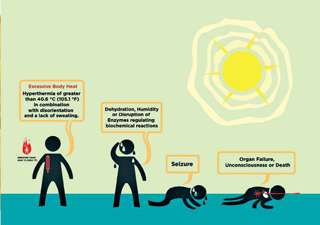What to do during a heatstroke?
What to do during a heatstroke?
 With summer at its peak, there are high chances of people getting heat or sunstroke. Heat stroke is one of the most serious forms of heat injury and is also considered a medical emergency.
With summer at its peak, there are high chances of people getting heat or sunstroke. Heat stroke is one of the most serious forms of heat injury and is also considered a medical emergency.The effects of heatstroke are known to damage the brain and injure internal organs, and can affect people across all age groups. A heat stroke generally occurs due to prolonged exposure to high temperatures along with the combination of dehydration that damages the body's temperature control system. Some of the common symptoms of a heat stroke are nausea, seizures, confusion, disorientation, loss of consciousness and sometimes coma.
Other symptoms of heatstroke include-
-
Throbbing headaches
-
Dizziness
-
Lack of sweat despite the heat
-
Muscle cramps and weakness
-
Vomiting
-
Shallow breathing
How to indicate a heat or a sunstroke?
 If a person is displaying any of the mentioned heat-related symptoms, it is essential to take their temperature. A reading of 104°F or more means that the person is suffering from a heat stroke. It is important that you call or inform the emergency service or, rush the person to medical care unit immediately.
If a person is displaying any of the mentioned heat-related symptoms, it is essential to take their temperature. A reading of 104°F or more means that the person is suffering from a heat stroke. It is important that you call or inform the emergency service or, rush the person to medical care unit immediately. What kind of people are generally affected by a heatstroke?
Babies, children and elderly people are more prone to get heatstrokes. People who are obese or have any heart-related diseases are also prone to heatstroke. Studies also say that people who are constantly outdoors or any hot setting are also at risk of getting heat or sunstroke.
Precautions against heatstroke-
-
The most important precaution is to stay indoors if the temperature and heat index is high. If possible, stay indoors in air-conditioned areas.
-
If you are stepping outdoors, wear lightweight, light coloured, loose fitting clothes.
-
Protect yourself from the sun by wearing a hat or use an umbrella.
-
Use a sunscreen that has a sun protection factor (SPF) of 15 or higher.
-
Drink plenty of water throughout the day. Consume liquids such as fruit juice and sports drinks even if you don’t feel thirsty.
-
Limit or avoid drinks that contain caffeine or alcohol.
-
Take frequent breaks from exercises and outdoor activities.
-
Do not stay inside the car when it is too hot. Use the A/C during the day while travelling.
Steps to follow when you have a heat stroke-
-
 Get out of the heat immediately and place yourself in a shady or cool place.
Get out of the heat immediately and place yourself in a shady or cool place. -
Lie down and elevate your legs to get the blood flowing to the heart.
-
Take off any tight or extra clothing.
-
Place a wet towel/handkerchief on the forehead to get the temperature down. If possible, take a cool bath as this will help regulate and lower your internal body temperature.
-
Drink water or any cool liquid and sip them frequently.
What to do if the effects of the heatstroke don't go down?
-
Call emergency services or an ambulance if the body temperature reads 102°F or higher even after 30 minutes of initial treatment.
-
If the person faints or has seizures, then immediately take the person to the hospital.
- If the person is not breathing, CPR should be immediately administered and the person should be taken to the hospital immediately.





















